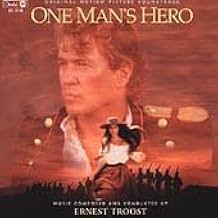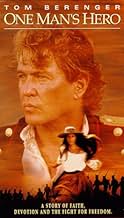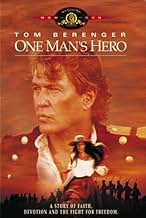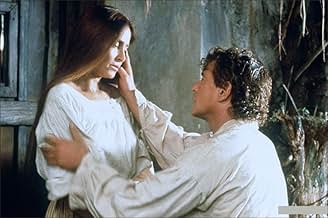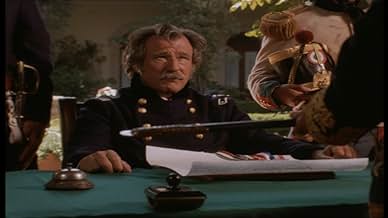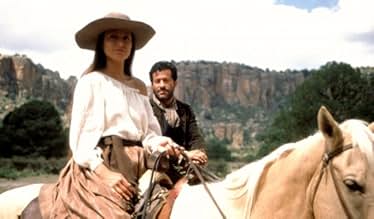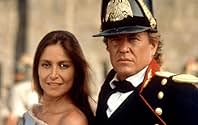IMDb RATING
6.0/10
1.4K
YOUR RATING
John Riley, an Irish immigrant soldier recruited in the American army during the Mexican-American War faces anti-immigrant and anti-Catholic bigotry from his fellow servicemen and defects to... Read allJohn Riley, an Irish immigrant soldier recruited in the American army during the Mexican-American War faces anti-immigrant and anti-Catholic bigotry from his fellow servicemen and defects to the Mexican army.John Riley, an Irish immigrant soldier recruited in the American army during the Mexican-American War faces anti-immigrant and anti-Catholic bigotry from his fellow servicemen and defects to the Mexican army.
- Awards
- 3 nominations
- Director
- Writer
- All cast & crew
- Production, box office & more at IMDbPro
Storyline
Did you know
- TriviaIn John Riley's first scene as a San Patricio, he asks their names to other Irish soldiers. When he asks his name to James Kelly, Riley asks him if he has any experience, and Kelly answers that he has been in His Majesty Royal Artillery. Riley replies with, "Good experience, but there is no royalty here", to what Kelly answers, "Yes, sir". Kelly is played by Prince Albert of Monaco, a member of the Royal family of Monaco.
- GoofsThere are a number of geographical and historical errors in this film, including some scenes in the battle of Churubusco (the last battle in the movie).
Featured review
When it comes films based on true events, it is in the filmmakers' best interest to keep all the facts as legitimate as possible without skewing the story all that much. The genre of films that probably receives the most critical of film buffs' attentions are the ones that have been historically recorded and not some fable spread by rumors and myths. Taking a deeper look, the type of historical film that gets this kind of focus is usually bio-pictures or war dramas. Further closing the gap, the war dramas that have received the motion picture treatment range; but several have depicted these tragedies during the Great War, World War II, the Vietnam War, the Revolutionary War and the American Civil War. Of course in world history, these are not the only confrontations that occurred, but for North American history, this is the usual batch. It is rare when another event is looked at that possibly was forgotten in the regular high school history books. The most recent that comes to mind is Heaven's Gate (1980), which was about a county war in 1890.
Turns out this movie takes place during the 19th century as well. Lance Hool, a producer to other various films like Missing in Action (1984), The Air Up There (1994), Flipper (1996) and Man on Fire (2004), takes a turn in the director's chair to cover the Mexican-American War in 1846. Written by Milton S. Gelman (who passed practically a decade before this film's release), the story is about real-life soldier Sergeant John Riley (Tom Berenger) and his men who abandoned the U.S. army after being persecuted because of their Catholic faith. While leaving, they find refuge with fellow Mexicans led by Cortina (Joaquim de Almeida) and Marta (Daniela Romo). There, they both decide to join Mexico and fight for their freedom. Meanwhile, Colonel Benton Lacy (Mark Moses) attempts to get Riley back to the north before General Winfield Scott (Patrick Bergin) blows them all away. Running parallel to that, Marta and Riley start to become more attracted to each other every minute they spend together.
For problems, there isn't all too much to gripe about. The only script issues that are obvious deal with character motivations. From what is known, John Riley is somewhat a mystery but only after the Mexican- American war ended. There are documents of his existence but there isn't a clear answer as to what he did post-war. Did he marry for real? In this feature, Marta is Riley's love interest as is she to Cortina. The passion that Riley has for Marta is a constant subplot that is brought up every half-hour or so. Yet Cortina repetitively reminds Riley to stay away, but Riley doesn't listen. Soon, Riley and Cortina fight and immediately right after; it's water under the bridge for some odd reason. What was all the antagonizing for if it was going to be settled so quickly? Was it even worth writing in? The only other dilemma in this movie is more technical and that's the depiction of war. This film was Orion Pictures last release and many of the studio's films were rated R (as was this one). Still there seems to be almost no blood or gore.
That particular aspect was probably the most inaccurate component. War is not light and fluffy stuff. There are a couple scenes where blood does flow but it's rated R. Gettysburg (1993) also should have been R but it was PG so the depiction of violence was much less gruesome and that's only appropriate because of its rating. Why give a movie the label of rated R if won't even play out as an R rated film? It's misleading. The cast to the film was also entertaining. Hearing Tom Berenger with an Irish accent is definitely a change in his usual speech pattern and it does sound authentic, as well as the soldiers played by Stuart Graham, Gregg Fitzgerald, Don Wycherley, Wolf Muser and Luke Hayden. Each actor equally matches Berenger in amiability. Daniela Romo as Marta is very pretty and it is obvious as to why Riley falls for her so quickly. Joaquim de Almeida is always fun to watch but in his role as Cortina, it's hard to know how trustworthy he is. Mark Moses performance as Colonel Lacy is another great show. Moses knows how to have a presence.
Visually, the film had an appealing look to it. All effects looked like they were executed practically, of which regularly gives a movie a more realistic viewing. Credit to João Fernandes as the director of photography for capturing wide shots of the western North American terrain. The actual depiction may not feel it has the right temperature to walk in casual clothing but it rightfully matches the environment of what the west was like. Fernandes was also the cinematographer for Friday the 13th Part IV: The Final Chapter (1984), Missing in Action (1984) and Red Scorpion (1988). The film score produced by Ernest Troost was another great element. Troost also composed the music to both horror comedies Tremors (1990) and Dead Heat (1988). Unlike Dead Heat (1988) though where the orchestra sounded like it came from an oldies monster film, Troost's orchestra to this film is much more full and contemporary. The main title is very applicable to the setting, with bagpipes representing Riley and his men. There's also a choir to boot.
It has some weird character motivations and underwhelming violence for an R rated war film, however it is an immersive film. The story provides a new history lesson to those unfamiliar of the Mexican-American war, the actors perform great, and the cinematography is befitting to the setting as well as the film score.
Turns out this movie takes place during the 19th century as well. Lance Hool, a producer to other various films like Missing in Action (1984), The Air Up There (1994), Flipper (1996) and Man on Fire (2004), takes a turn in the director's chair to cover the Mexican-American War in 1846. Written by Milton S. Gelman (who passed practically a decade before this film's release), the story is about real-life soldier Sergeant John Riley (Tom Berenger) and his men who abandoned the U.S. army after being persecuted because of their Catholic faith. While leaving, they find refuge with fellow Mexicans led by Cortina (Joaquim de Almeida) and Marta (Daniela Romo). There, they both decide to join Mexico and fight for their freedom. Meanwhile, Colonel Benton Lacy (Mark Moses) attempts to get Riley back to the north before General Winfield Scott (Patrick Bergin) blows them all away. Running parallel to that, Marta and Riley start to become more attracted to each other every minute they spend together.
For problems, there isn't all too much to gripe about. The only script issues that are obvious deal with character motivations. From what is known, John Riley is somewhat a mystery but only after the Mexican- American war ended. There are documents of his existence but there isn't a clear answer as to what he did post-war. Did he marry for real? In this feature, Marta is Riley's love interest as is she to Cortina. The passion that Riley has for Marta is a constant subplot that is brought up every half-hour or so. Yet Cortina repetitively reminds Riley to stay away, but Riley doesn't listen. Soon, Riley and Cortina fight and immediately right after; it's water under the bridge for some odd reason. What was all the antagonizing for if it was going to be settled so quickly? Was it even worth writing in? The only other dilemma in this movie is more technical and that's the depiction of war. This film was Orion Pictures last release and many of the studio's films were rated R (as was this one). Still there seems to be almost no blood or gore.
That particular aspect was probably the most inaccurate component. War is not light and fluffy stuff. There are a couple scenes where blood does flow but it's rated R. Gettysburg (1993) also should have been R but it was PG so the depiction of violence was much less gruesome and that's only appropriate because of its rating. Why give a movie the label of rated R if won't even play out as an R rated film? It's misleading. The cast to the film was also entertaining. Hearing Tom Berenger with an Irish accent is definitely a change in his usual speech pattern and it does sound authentic, as well as the soldiers played by Stuart Graham, Gregg Fitzgerald, Don Wycherley, Wolf Muser and Luke Hayden. Each actor equally matches Berenger in amiability. Daniela Romo as Marta is very pretty and it is obvious as to why Riley falls for her so quickly. Joaquim de Almeida is always fun to watch but in his role as Cortina, it's hard to know how trustworthy he is. Mark Moses performance as Colonel Lacy is another great show. Moses knows how to have a presence.
Visually, the film had an appealing look to it. All effects looked like they were executed practically, of which regularly gives a movie a more realistic viewing. Credit to João Fernandes as the director of photography for capturing wide shots of the western North American terrain. The actual depiction may not feel it has the right temperature to walk in casual clothing but it rightfully matches the environment of what the west was like. Fernandes was also the cinematographer for Friday the 13th Part IV: The Final Chapter (1984), Missing in Action (1984) and Red Scorpion (1988). The film score produced by Ernest Troost was another great element. Troost also composed the music to both horror comedies Tremors (1990) and Dead Heat (1988). Unlike Dead Heat (1988) though where the orchestra sounded like it came from an oldies monster film, Troost's orchestra to this film is much more full and contemporary. The main title is very applicable to the setting, with bagpipes representing Riley and his men. There's also a choir to boot.
It has some weird character motivations and underwhelming violence for an R rated war film, however it is an immersive film. The story provides a new history lesson to those unfamiliar of the Mexican-American war, the actors perform great, and the cinematography is befitting to the setting as well as the film score.
- breakdownthatfilm-blogspot-com
- Jun 6, 2016
- Permalink
- How long is One Man's Hero?Powered by Alexa
Details
- Release date
- Countries of origin
- Languages
- Also known as
- Herois sense pàtria
- Filming locations
- Sierra de Organos, Sombrerete, Zacatecas, Mexico(exterior scenes)
- Production company
- See more company credits at IMDbPro
Box office
- Budget
- $11,350,000 (estimated)
- Gross US & Canada
- $240,067
- Opening weekend US & Canada
- $108,567
- Sep 26, 1999
- Gross worldwide
- $240,067
- Runtime2 hours 1 minute
- Color
- Sound mix
- Aspect ratio
- 2.35 : 1
Contribute to this page
Suggest an edit or add missing content


